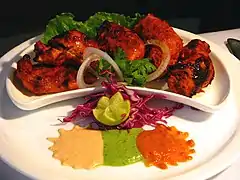 A carafe and glass of lassi | |
| Type | Yogurt beverage |
|---|---|
| Place of origin | India |
| Associated cuisine | Cuisine of India |
| Serving temperature | Chilled |
| Main ingredients | Yogurt, water |
Lassi (pronounced [ləsːi]) is an Indian yogurt–based beverage with a smoothie-like consistency.[1][2] It has been called "the most popular and traditional yogurt-based drink" in India.[3] It has also been described as the form in which yogurt "is most cherished and unbeatably popular in[...]Punjab," its "best-loved summer drink", and "the air conditioner of the Punjab."[4]
Lassi originated in the Punjab region of the Indian subcontinent.[3] The word lassi means yogurt mixed with water in Punjabi.[5]
Lassi is prepared by blending yogurt, water, and spices. In Punjab, the yogurt is traditionally made from water buffalo milk.[4] However, variations of lassi can be prepared in different ways. Cumin and cardamom are the most common spices added to lassi.[6] Lassi is traditionally served in a clay cup known as kulhar.[6]
Varieties
Namkin lassi
Namkin (salty) lassi is made by adding black pepper, cumin, and sugar to the yogurt-water mixture.[1]
Lassi masalewal
Lassi masalewal (spicy lassi) is made by adding ingredients such as almonds, ginger, green chilies, and pistachios to namkin lassi.[1]
Meethi lassi
Meethi (sweet) lassi is made by adding cardamom, rosewater, and saffron to the yogurt-water mixture.[1][3]
Bhang lassi
Bhang lassi is a cannabis-infused drink that contains bhang, a liquid derivative of cannabis, which has effects similar to other eaten forms of cannabis.[7] It is legal in many parts of India and mainly sold during Holi, when pakoras containing bhang are also sometimes eaten. Uttar Pradesh is known to have licensed bhang shops, and in many places, one can buy bhang products and drink bhang lassis.[8]
Others
Fruits such as mangos and strawberries may be added to the yogurt-water mixture to yield, for example, mango lassi and strawberry lassi.[1][3]
In popular culture
A 2008 print[9] and television[10][11] ad campaign for HSBC, written by Jeffree Benet of JWT Hong Kong, tells the tale of a Polish washing machine manufacturer's representative sent to India to discover why their sales are so high there. On arriving, the representative investigates a lassi parlor, where he is warmly welcomed, and finds several washing machines being used to mix it. The owner tells him he is able to "make ten times as much lassi as I used to!"
In 2013, a group of IIT Kharagpur students lobbied Google to name its next Android version Lassi.[12]
Gallery
See also
References
- 1 2 3 4 5 Kurlansky, Mark (2018). Milk! A 10,000-Year Food Fracas. Bloomsbury Publishing. p. 266.
- ↑ Dhalwala, Meeru (2012). Vij's: Elegant and Inspired Indian Cuisine. Douglas and McIntyre (2013) Limited. p. 191.
- 1 2 3 4 Shah, Niraalee (2021). Indian Etiquette: A Glimpse Into India's Culture. Notion Press. p. 289.
- 1 2 Semali, Ladislaus (2002). What is Indigenous Knowledge? Voices from the Academy. Taylor & Francis. p. 173.
- ↑ Kurlansky, Mark (2018). Milk! A 10,000-Year Food Fracas. Bloomsbury Publishing. p. 266.
Of Punjabi origin, the word "lassi" simply signifies yogurt mixed with water to make it drinkable.
- 1 2 "lassi | beverage". www.britannica.com. Archived from the original on 2017-12-06. Retrieved 2022-07-24.
- ↑ Staelens, Stefanie (10 March 2015). "The Bhang Lassi Is How Hindus Drink Themselves High for Shiva". Vice.com. Archived from the original on 2017-08-11. Retrieved 2017-08-10.
- ↑ Anthony Bourdain: No Reservations Collection 2, Episode 5; Final Segment.
- ↑ "Can This Lassi Ad Really Be True?". indiablogs.searchindia.com. 2008-10-04.
- ↑ "HSBC Bank : Washing Machine and Lassi". Adoholik. 2008-09-27. Archived from the original on 2008-10-09. Retrieved 2008-10-19.
- ↑ "HSBC Lassi/Washing Machines TV Ad". HSBC. 2012-04-30. Archived from the original on 2013-10-17. Retrieved 2013-09-23.
- ↑ "IIT grads plead Google to name Android version Lassi". The Times of India. 11 September 2013. Archived from the original on 2021-12-13. Retrieved 2021-12-12.


.jpg.webp)






